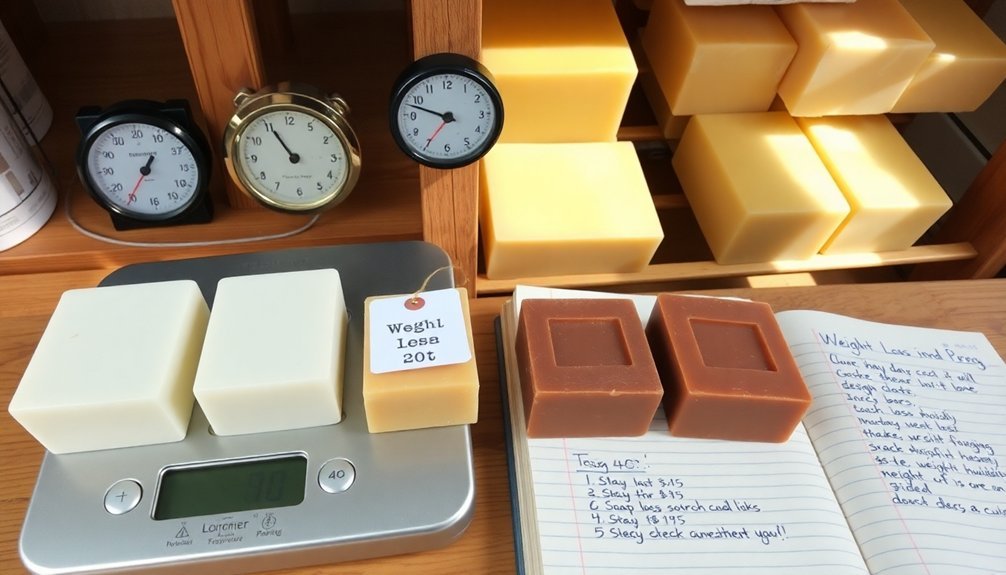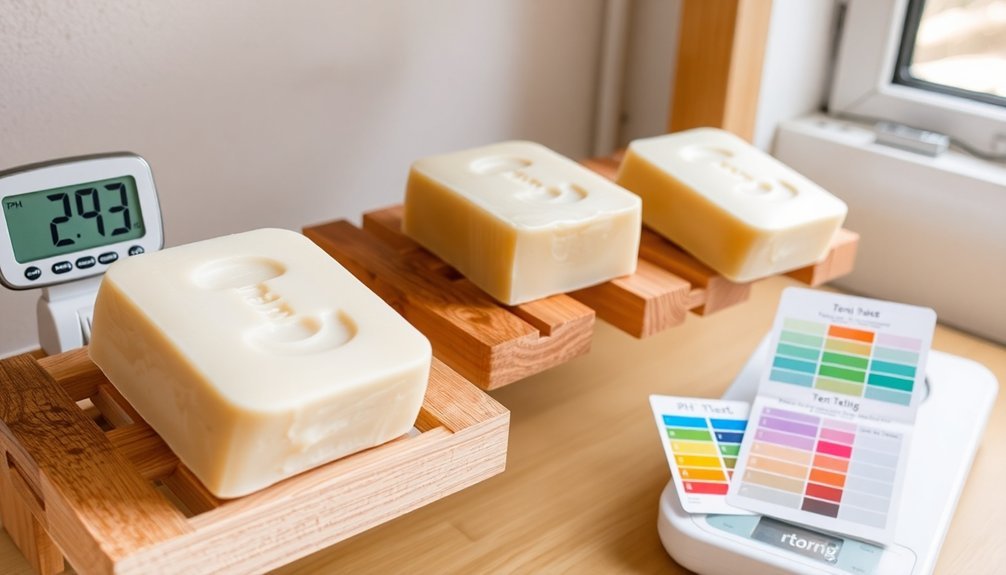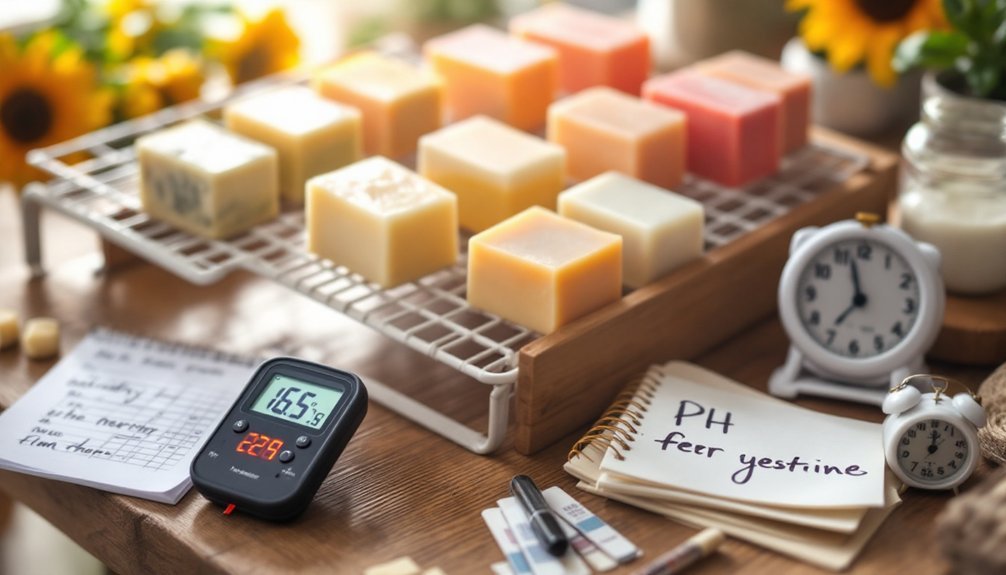To monitor soap curing conditions effectively, you'll need three smart approaches. First, track weight loss regularly with a precision scale to determine moisture content and maturity. Second, create a controlled environment using thermostats, hygrometers, and proper air circulation systems that maintain ideal temperature (60-70°F) and humidity (40-60%). Third, implement physical testing methods like pH tests, break tests, and lather assessments weekly. These scientific approaches will transform your soap making from guesswork to precision craft.
Tracking Weight Loss to Determine Moisture Content

Tracking weight loss during soap curing provides essential data on the soap's moisture content and overall maturity.
You'll need a precision scale to accurately measure your soap bars at regular intervals throughout the 4-8 week curing period.
Select representative test bars from each batch and weigh them in consistent environmental conditions. Record these measurements in a log or graph to visualize the moisture loss pattern.
You'll notice your soap is properly cured when weights stabilize over two consecutive weeks.
Temperature and humidity greatly affect curing rates—higher temperatures accelerate evaporation while high humidity slows it. Using a dehumidifier in curing rooms can help control moisture levels in humid environments like Florida.
For commercial production, stable weights are vital to prevent misbranding on packaging.
As moisture decreases, you'll observe improvements in hardness, lather quality, mildness, and longevity of your finished soap.
Creating a Controlled Environment With Digital Monitoring
Creating a controlled environment for soap curing transforms an artisanal process into a precision science.
You'll want to maintain temperatures between 60-70°F using thermostatic control systems or smart thermostats that offer remote monitoring capabilities.
Install hygrometers to track humidity levels, keeping them at 40-60% with dehumidifiers when necessary.
Shield your soaps from direct sunlight using LED lighting without UV emissions to prevent discoloration.
Ensure proper air circulation with strategically placed fans and wire-coated racks that allow airflow around each bar.
For thorough monitoring, integrate IoT devices that track all environmental conditions simultaneously. Daily inspection of the curing soaps can help you assess if complete saponification is occurring properly throughout the batch.
Physical Testing Methods to Verify Curing Progress

Reliable physical testing methods serve as essential checkpoints during the soap curing process, helping you determine when your bars have reached peak quality. Beyond simply waiting the recommended 4-6 weeks, you'll need concrete ways to verify your soap has fully cured. Wait at least 24-48 hours after making soap before conducting any pH testing to ensure saponification has properly begun.
| Test Type | What to Check | Indicates |
|---|---|---|
| pH Testing | 8-10 range | Safe alkalinity levels |
| Break Test | Firmness when bent | Proper hardness development |
| Lather Test | Foam quality | Saponification completion |
You can implement these tests weekly during curing. The pH test confirms chemical safety, while break and lather tests reveal physical readiness. Don't rely solely on visual cues—combine multiple testing methods for the most accurate assessment of your soap's curing progress.
Frequently Asked Questions
Can Essential Oils Affect Curing Time and Monitoring Methods?
Essential oils can influence your soap's texture, potentially slowing curing. You'll need to adapt monitoring by checking hardness, weight changes, and scent consistency more regularly to guarantee proper curing despite these added variables.
How Does Altitude Impact Soap Curing Conditions?
At higher altitudes, your soap will likely lose water faster due to lower air pressure. You'll need to monitor humidity levels closely and may want to adjust your curing setup with proper ventilation.
Are There Smartphone Apps Specifically Designed for Soap Makers?
Yes, you'll find several smartphone apps designed specifically for soap makers, including Soap App by Bramble Berry and Soapmaking Friend. They'll help you calculate recipes, track inventory, and set curing reminders.
When Is a Soap Considered "Over-Cured"?
Your soap is over-cured when it becomes brittle, loses moisture, produces less lather, and shows visible cracks. You'll notice it feels harsh on your skin and doesn't provide the moisturizing benefits anymore.
Do Different Oil Bases Require Different Monitoring Approaches?
Yes, different oil bases do require tailored monitoring. You'll need to track harder oils more closely for crystallization rates, while softer oils demand attention to water evaporation patterns and potential rancidity development.
In Summary
You've now mastered three effective approaches to monitor your soap's curing journey. By tracking weight loss, creating a digitally monitored environment, and performing regular physical tests, you'll know exactly when your soap is perfectly cured. These methods take the guesswork out of the process, ensuring you'll produce consistent, high-quality soap that's ready for use or sale at precisely the right time.





Leave a Reply